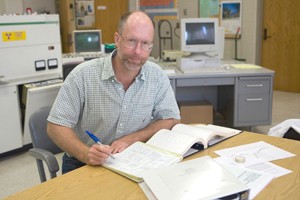
Cincinnati's Algeo Tracks Evidence of 'The Great Dying'
More than 251 million years ago, at the end of the Permian period, Earth almost became a lifeless planet. Around 90 percent of all living species disappeared then, in what scientists have called The Great Dying.
Thomas J. Algeo, has spent much of the past decade investigating the chemical evidence buried in rocks formed during this major extinction. The University of Cincinnati professor of geology has worked with a team of scientific colleagues to understand the ancient catastrophe. Algeo will present his latest findings at the annual meeting of the Geological Society of America, Oct. 31 to Nov. 3, in Denver.
The world revealed by Algeos research sounds horrific and alien a devastated landscape, barren of vegetation, scarred by erosion from showers of acid rain, huge dead zones in the oceans and runaway greenhouse gases leading to sizzling temperatures. This was Earth, 251 million years ago.
The more famous K-T extinction between the Cretaceous and Tertiary periods in which the dinosaurs went extinct was triggered by a large meteoroid or bolide striking the Earth. The Great Dying, between the Permian and Triassic periods, has another culprit.
The Permian-Triassic extinction event is still not fully understood, Algeo said. It took some time, but it finally dawned on the geologic community that this was not caused by a bolide.
Algeo and his colleagues from around the world are building a better understanding of the events that all but erased life from our planet. The work involves five principal investigators in addition to Algeo. The National Science Foundation has provided several substantial grants to support the research.
The evidence Algeo and his colleagues are looking at points to massive volcanism in Siberia. A large portion of western Siberia reveals volcanic deposits five kilometers (three miles) thick, covering an area equivalent to the continental United States.
It was a massive outpouring of basaltic lava, Algeo said. And, the lava flowed where it could most endanger life, through a large coal deposit.
Algeo noted that the dinosaur-killing bolide was lethal because it vaporized sulfur-rich sediments, resulting in extremely acidic rainfall. The effects of the Siberian lava eruption were likewise amplified by the coal deposit.
The eruption released lots of methane when it burned through the coal, he said. Methane is 30 times more effective as a greenhouse gas than carbon dioxide. Were not sure how long the greenhouse effect lasted, but it seems to be thousands of years, maybe tens of thousands of years.

Permian sea floor
A lot of the evidence ended up being washed into the ocean, and that is where Algeo and his colleagues look for it. Today, those oceanic deposits are found in Canada, China, Vietnam, Pakistan, India, Spitsbergen and Greenland.
In Denver, Algeo, with Margaret Fraiser of the University of Wisconsin-Milwaukee, will chair a session on New Developments in Permian-Triassic Paleoceanography to review some of the newly analyzed evidence. For this session, Algeo contributed to two presentations that suggest the Siberian lava eruption may not have been the only agent of global death during the late Permian.
An analysis of the carbon content of marine sediments at 33 locations around the world shows similar patterns, except for rocks now preserved in southern China. While most rocks deposited during the extinction show increased concentrations of total organic carbon and higher organic carbon accumulation rates, the Chinese samples show the opposite effect.

Permian sea floor
Its probable that were seeing evidence of an explosive regional volcanic eruption, Algeo said. The sediments there are just sterilized. It may be that the combined effects of this local volcanism and global climate change were especially lethal.
Algeo will also present research on the conditions leading to oxygen depletion in the oceans during the late Permian. Warm global climates certainly played a part as uniformly hot conditions stifled turnover by ocean currents. However, Algeo believes that chemical weathering by acid rain and similar processes also contributed. When erosion seven times the normal rate sent large flows of nutrients into the ocean, it created conditions much like the over-fertilization we see today near the outlets of large rivers. As it does today, this condition led to a microbial feeding frenzy and the removal of oxygen and life from the late Permian ocean.
If there is a lesson to all this, Algeo said, it is a reminder that things can get out of whack pretty quickly and pretty seriously. We are used to a stable world, but it may not always be so stable.
Related Stories
OTR mural celebrates UC alumni success
April 4, 2025
The UC Alumni Association, UCAA, will mark its annual Alumni Celebration during its upcoming Alumni Week, April 7-13, with a community art project commemorating this year’s slate of alumni honorees receiving the organization’s top awards.
UC Journalism to host Hall of Fame, Young Alumni Awards
Event: April 24, 2025 6:00 PM
The College of Arts and Sciences’ journalism department will host the Hall of Fame and Young Alumni Awards to celebrate the achievements and accomplishments of its graduates. Induction into the UC Journalism Hall of Fame is a special honor reserved for UC alumni who have excelled in the profession of journalism and media, or individuals who have made a significant contribution to journalism at UC.
Bradford pear trees look pretty, smell awful. Why are they...
April 2, 2025
WLWT talks to UC biology Professor Theresa Culley about Ohio's ban on the sale or planting of nonnative and invasive pear trees. The trees are showing up in many parks and wild areas where they are crowding out native species.
